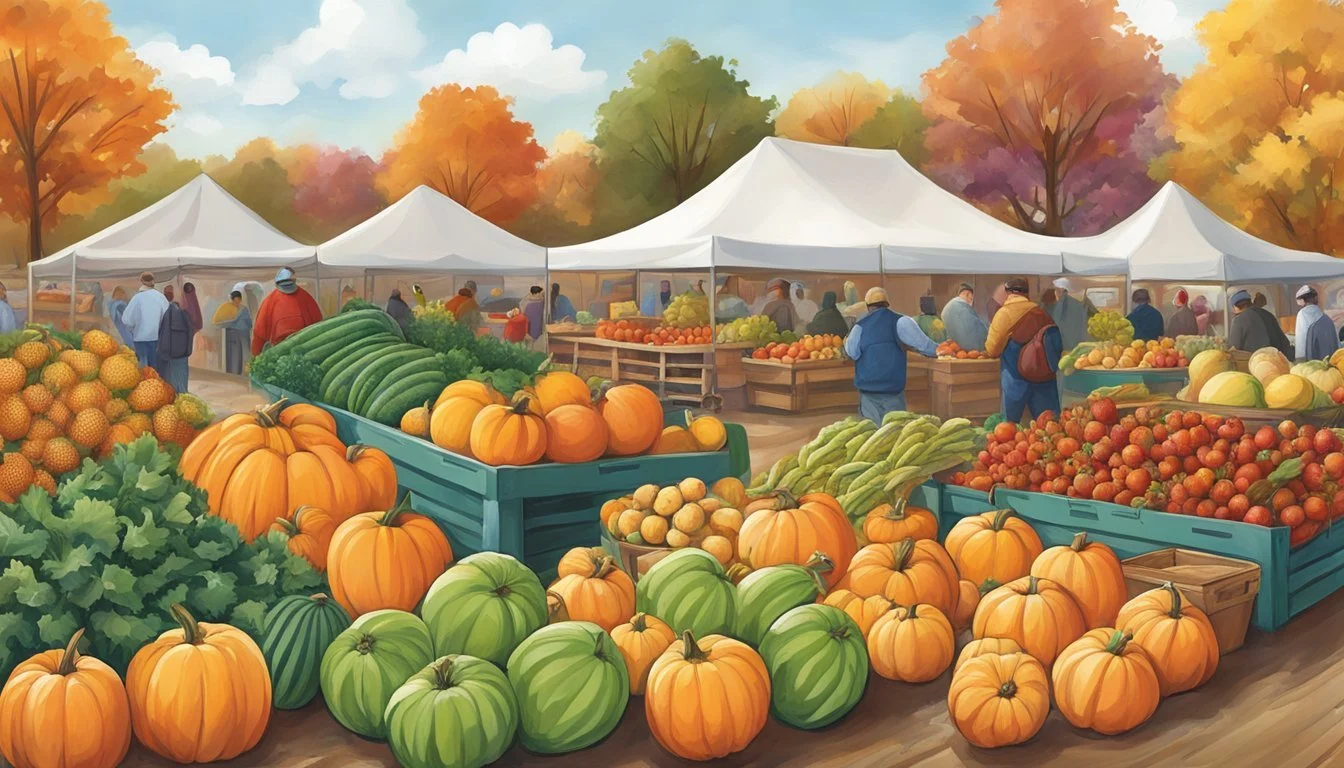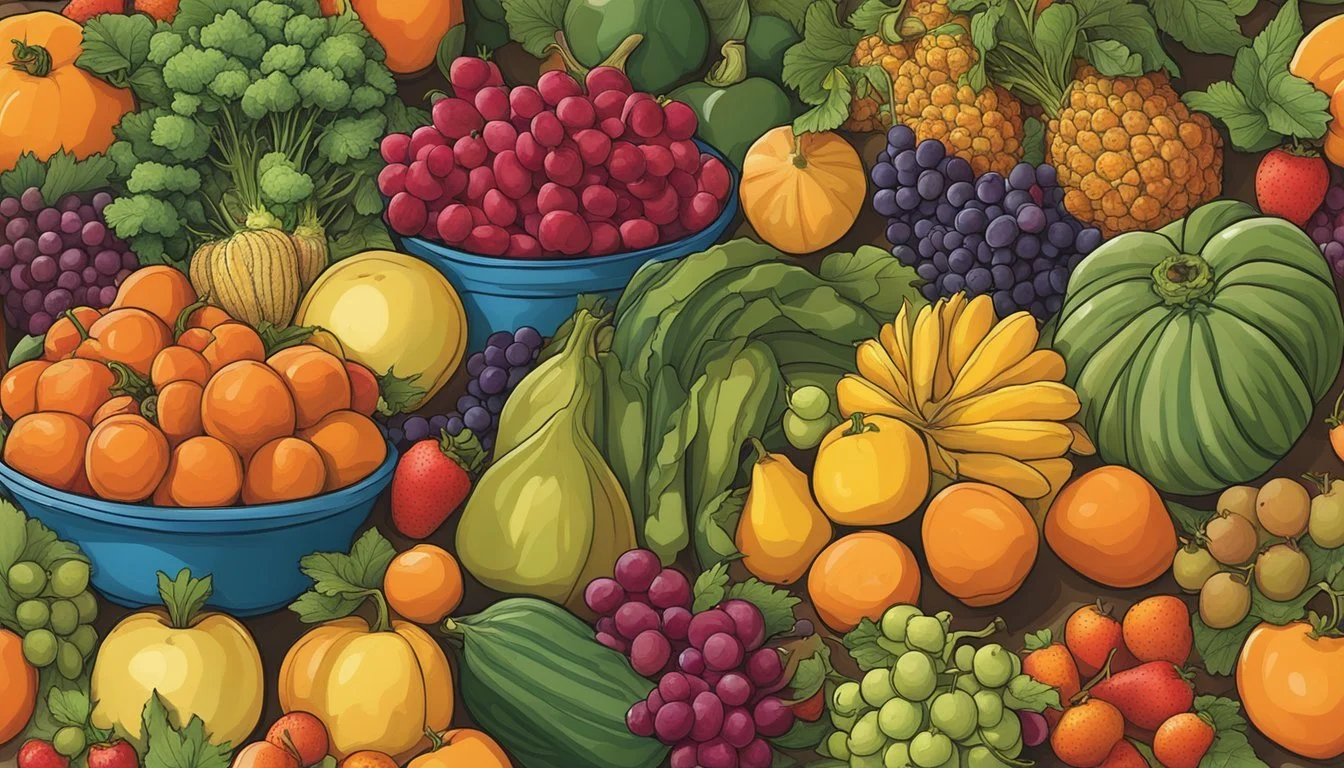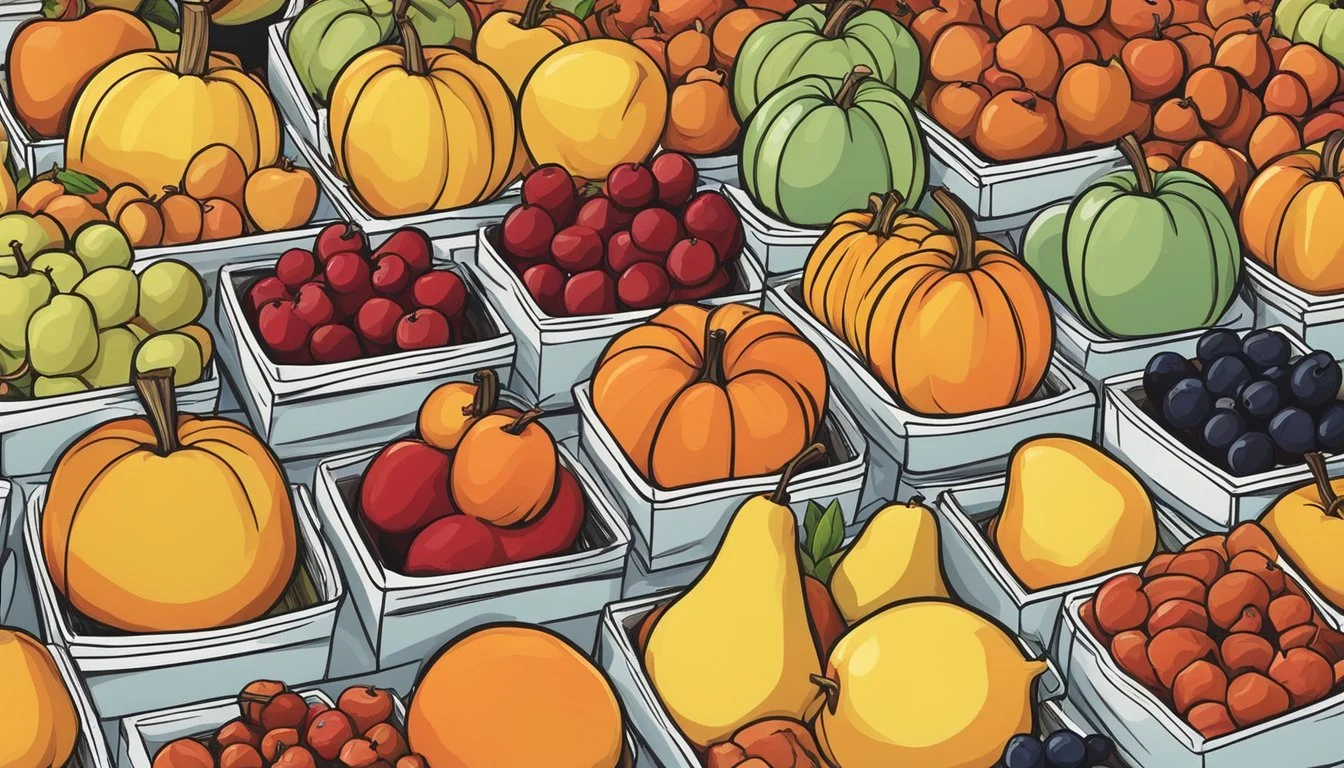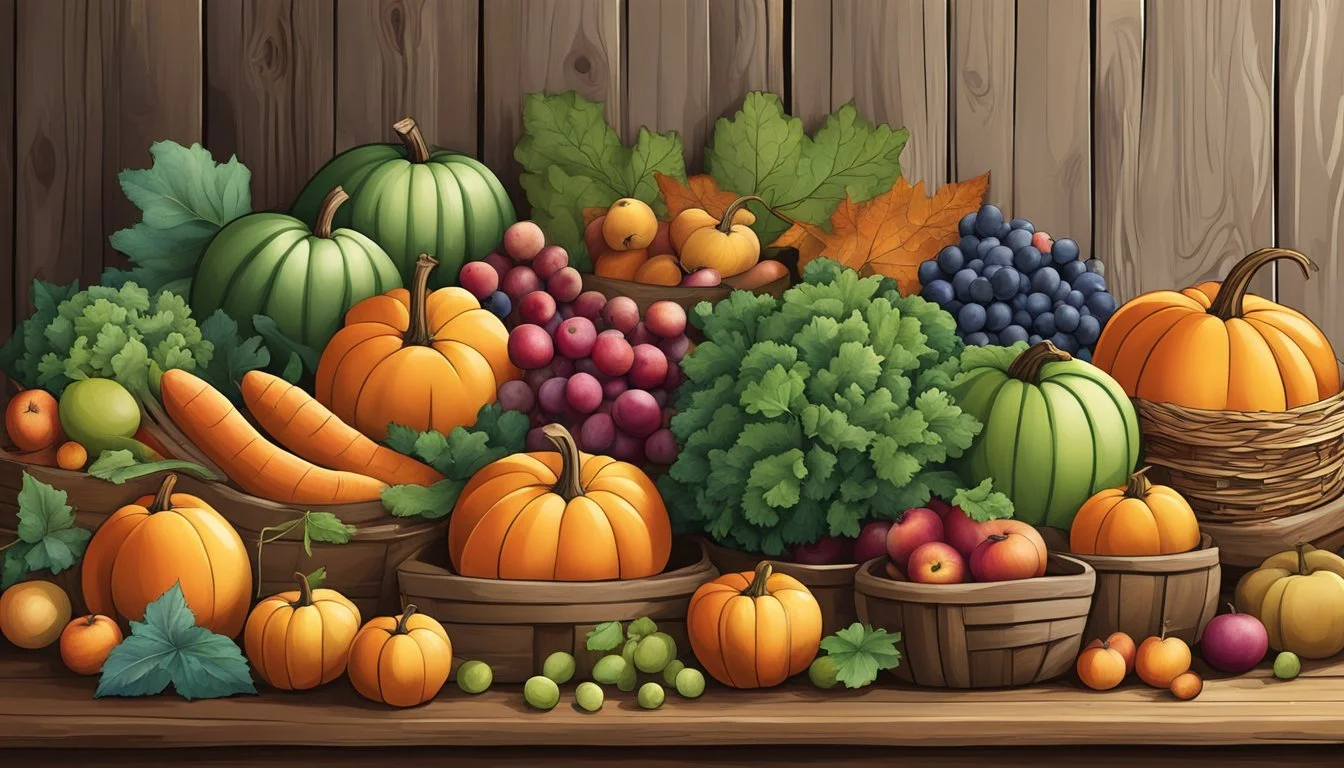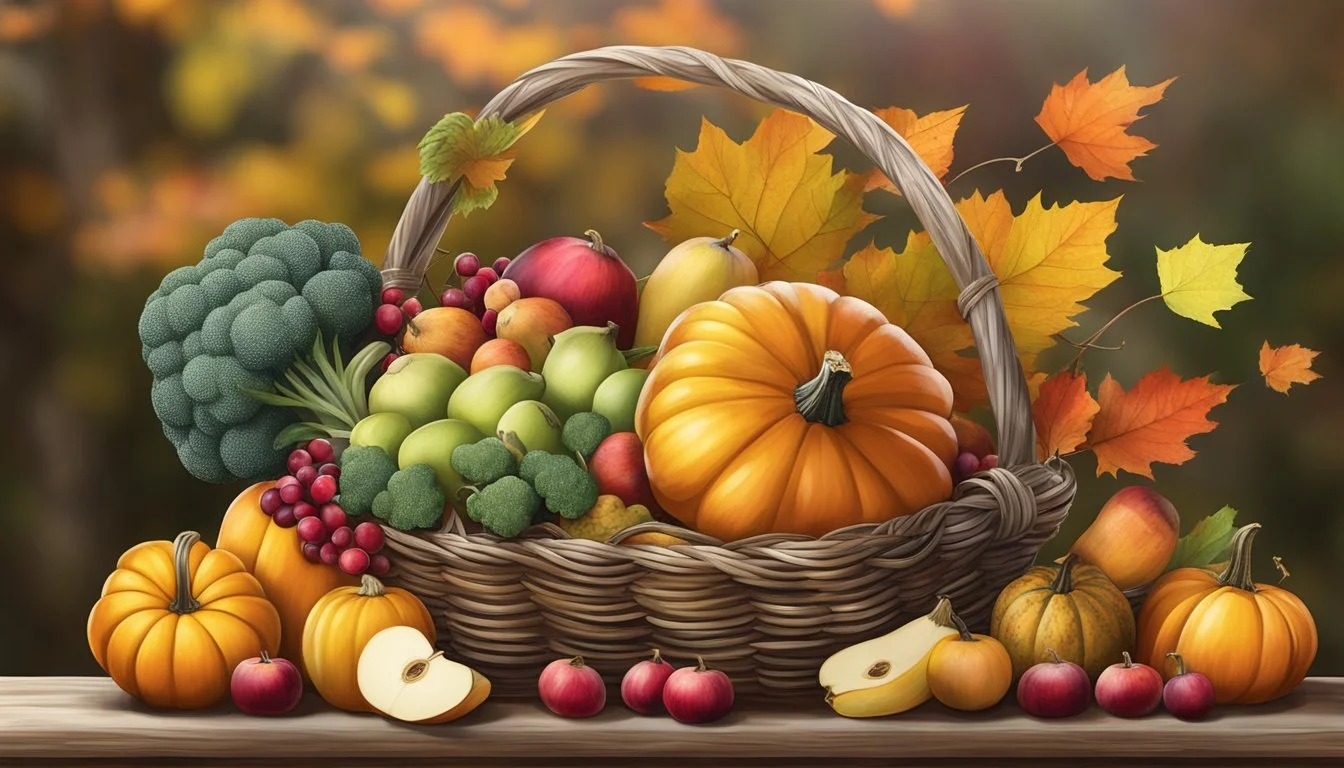Kentucky Seasonal Fruit & Vegetables in November
Your Fresh Guide
This Article is Part of our Kentucky Seasonal Fruit & Veg Calendar
As the amber hues of fall blanket the landscape, Kentucky’s harvest continues to offer an array of seasonal produce in November. The cooler weather marks a shift in the agricultural calendar, with a focus on hearty vegetables and the last of the autumn fruit. Seasonal eating during this month not only provides a rich taste experience but also ensures high nutritional content and supports local agriculture. Consumers can approach their November selections with confidence, knowing that they are choosing products that are cultivated for peak seasonality and flavor.
They will find that the November produce in Kentucky consists largely of robust vegetables and a variety of leafy greens. The frost-sweetened kale (What wine goes well with kale?) and spinach (What wine goes well with spinach?), with their nutrient-dense leaves, are at their best during this time. Root vegetables such as radishes and turnips also thrive in the November chill, offering earthy flavors (What wine goes well with earthy flavors?) and rich textures to the seasonal palate. When it comes to fruits, the options may be limited, yet there are still fresh choices available such as apples, which can be stored well into the winter months.
Consumers in Kentucky are fortunate to have a selection of produce that extends well into late autumn, affording them the pleasure and health benefits of fresh fruits and vegetables even as the year winds down. The knowledge of what is in season for November helps to make informed choices, supporting local farmers while enjoying some of the freshest and tastiest produce available.
The Importance of Eating Seasonally
Eating seasonally in Kentucky during November offers enhanced nutritional value, reduces environmental impact, and bolsters the local economy. Fresh produce that is in season often contains higher levels of key nutrients such as fiber and antioxidants.
Nutritional Benefits
Produce picked during its peak season contains its maximum nutrients. For instance, root vegetables like sweet potatoes and winter squash, abundant in November, offer a high concentration of fiber and antioxidants. These nutrients are vital for maintaining digestive health and combating oxidative stress.
Environmental Impact
Choosing seasonal produce contributes to environmental sustainability. When fruits and vegetables are grown in their natural season, like kale and brussels sprouts (how long do brussels sprouts last?)in November, they require less human assistance, thus reducing energy consumption and minimizing carbon footprints associated with transportation.
Supporting Local Economy
Seasonal eating supports community farms and local businesses. When consumers purchase in-season produce directly from local farmers' markets, they are investing in their local economies. Additionally, this practice ensures freshness and reduces the distances that food travels, cutting back on transportation costs and resources.
Kentucky's Climate and Agriculture
Kentucky's diverse climate plays a crucial role in its agricultural output, influencing the growing seasons and the variety of produce available throughout the year.
Understanding Kentucky's Growing Seasons
The Commonwealth of Kentucky experiences four distinct seasons, each affecting agricultural practices differently. Summer in Kentucky is typically warm and humid, providing ample growing conditions for a variety of fruits and vegetables. However, winter brings colder temperatures that limit outdoor production. During the transitional period of November, which falls in late fall, the state witnesses cooler temperatures and a shift in the types of crops that can be cultivated successfully.
The growing seasons in Kentucky can be broadly categorized into:
Spring: March - May
Summer: June - August
Fall: September - November
Winter: December - February
The frost-free growing season typically begins in April and can last until October, giving farmers a generous window for most crops.
Impact of Climate on Produce Availability
Kentucky's climate has a significant impact on the availability of fresh produce. The shift from warm summer months to the cooler days of November sees a reduction in the variety of fruits and vegetables. During this time, farmers prepare for late fall and early winter crops.
Produce typically available in Kentucky during November includes:
Hardy vegetables: such as kale, collards, and Brussels sprouts
Root vegetables: like sweet potatoes and turnips
Greenhouse-grown produce: which can include tomatoes and lettuce
Temperature fluctuations and weather patterns, characteristic of November's climate, can influence when specific crops are planted and harvested, thus affecting their availability to consumers. Kentucky's agriculture must continually adapt to these climatic conditions to maintain year-round produce availability.
Seasonal Fruits in Kentucky
November in Kentucky marks the transition from fall to winter and brings a fruitful bounty. This section focuses on crucial knowledge about what fruits are in season, their harvest timelines, and how to prepare and store them.
Overview of Seasonal Fruits
Kentucky's climate in November allows residents to enjoy the final waves of autumn fruits before winter sets in. The fruits available during this month offer a rich mixture of flavors and health benefits that align perfectly with the season's culinary demands.
Apples: Just finishing their peak, varieties like Fuji and Pink Lady are still available.
Pears: Look for just-picked varieties that store well into winter.
Cranberries: Native to cooler climates, they are at the end of their season.
Pomegranates: Though not indigenous, they are available in markets, as they ripen in fall.
Persimmons: The local American persimmon variety reaches its peak ripeness.
Fruit Harvest Timelines
Harvest timelines are crucial to ensure the consumption of fruits at their best quality and taste.
Apples: Harvest can run into early November; specific varieties have tailored timelines.
Pears: Often harvested in late summer and early fall but store well and remain good into November.
Cranberries: Best harvested in late fall, just before the frosts set in.
Pomegranates: Typically harvested in September and October but remain in circulation.
Persimmons: They reach peak ripeness after the first frost, often in late October or November.
Preparation and Storage Tips
Proper preparation and storage are instrumental for maintaining the freshness and extending the shelf-life of fruits.
Apples and Pears: Store in a cool, dark place or refrigerator; wash and cut just before use to prevent browning.
Cranberries: Keep refrigerated in a sealed container; can also be frozen for long-term use.
Pomegranates: Store in a cool, dry place; seeds can be refrigerated or frozen in an airtight container.
Persimmons: Ripen at room temperature; once soft, refrigerate to prolong freshness.
Seasonal Vegetables in Kentucky
November marks a transitional period in Kentucky's agricultural calendar, where the harvest of late-season vegetables is in full swing. During this month, root vegetables and hardy greens are typically abundant, thriving in the cooling temperatures.
Overview of Seasonal Vegetables
In November, Kentuckians have access to a variety of vegetables that can withstand the cooler weather. These include root vegetables like beets, carrots, and sweet potatoes, as well as members of the brassica family, such as Brussels sprouts, cabbage, and kale. Other cold-hardy selections available are turnips, winter squash, and potatoes. The assortment of greens available extends to collards, mustard (how long does mustard last?), and other leafy varieties, which are often sweeter post-frost.
Vegetable Harvest Timelines
Kale: Harvest continues through late fall; the first frost improves its flavor.
Beets: Available until the ground freezes; best when harvested before they become oversized.
Brussels Sprouts: Harvest can extend into November; sprouts are sweeter after a frost.
Potatoes: Early November is typically the end of the potato harvest window.
Winter Squash: Varieties like butternut or acorn squash are usually harvested before the first heavy frost.
Turnips: Can be harvested throughout November, often more flavorful after a light frost.
Cabbage: Late-season varieties are harvested in early to mid-November.
Greens: Collards and other greens can be picked into November; flavor intensifies with cooler temperatures.
Sweet Potatoes: Should be harvested before the first frost to prevent damage.
Pumpkins: Harvesting concludes in late October, but they can be stored and used throughout November.
Carrots: Can be left in the ground and harvested as needed until the soil freezes.
Preparation and Storage Tips
Root vegetables such as beets, turnips, and carrots can be stored in a cool, dry place and last several months. Sweet potatoes and winter squash have a similar storage capability, provided they are kept in a well-ventilated area. Potatoes should be stored in a dark, cool environment to prevent sprouting. Kale and cabbage are best stored in a refrigerator's crisper drawer, where they can maintain freshness for a couple of weeks. Brussels sprouts can also be refrigerated and stay fresh for several days to a week. For optimal taste, greens should be consumed shortly after purchase or harvest, although they can be stored in a refrigerator for a short period.
November's Featured Produce
November in Kentucky ushers in a harvest rich with robust flavors and hearty produce, ideal for nourishing meals as the temperatures drop.
Spotlight on Root Vegetables
Root vegetables take center stage in November's cooler climate. Sweet potatoes and carrots offer vibrant colors and sweet, earthy flavors, and are versatile in everything from savory roasts to sweet desserts. Turnips, less sweet but no less nutritious, can be mashed, roasted, or incorporated into stews.
Sweet Potatoes: High in vitamins A and C, excellent for baking and casseroles.
Carrots: Great source of beta-carotene for roasting or in soups.
Turnips: Good for a low-carb potato substitute, fitting for various cooking methods.
Greens in the Spotlight
Kentucky sees a surge in leafy greens that thrive in the cooler weather. Kale and spinach are powerhouse vegetables, packed with essential nutrients and flexible enough for salads or warm dishes. Cabbage, with its crisp texture, becomes a staple in slaws, ferments, and sautéed side dishes.
Kale: Contains vitamins K, A, and C, suitable for chips or sautéed sides.
Spinach: Rich in iron and folate, perfect raw in salads or cooked down.
Cabbage: Versatile for pickling, fermenting, or as a cooked side.
Crucial Role of Squash and Pumpkins
Winter squash and pumpkins are not just for decoration but hold a significant spot in the culinary world, particularly in November. Their flesh is ideal for soups, purees, and pies. Pumpkins yield seeds that are a tasty, crunchy snack when roasted.
Winter Squash: Comes in varieties like butternut or acorn, commonly used in soups.
Pumpkin: Offers seeds for roasting, and flesh that enhances pies and bread.
Healthy Eating in November
November in Kentucky brings a cornucopia of fruits and vegetables that are not only fresh and tasty but also incredibly nutritious. This seasonal bounty provides an excellent opportunity to create wholesome meals that can be enjoyed with family and friends, especially around Thanksgiving.
Recipes for Seasonal Dishes
The cooler November weather is perfect for heartwarming dishes. Utilize local produce like sweet potatoes and pumpkin to make comforting recipes. One can try making a Sweet Potato Soup using sweet potatoes, onions, garlic, and a blend of warm spices, or a Pumpkin Chili loaded with ground turkey and black beans (how long do black beans last?) for a hearty and satisfying meal.
Salads and Side Dishes
Salads and sides become more than just accompaniments when made with seasonal produce. A vibrant Kale and Roasted Sweet Potato Salad with a mustard vinaigrette can be a standout dish. Cranberries add a burst of color and taste to any Thanksgiving salad, while roasted Brussels sprouts with a balsamic glaze can elevate a simple side into a flavorful experience.
Main Courses and Desserts
The main course often features seasonal vegetables as key ingredients. Roast turkey pairs excellently with a Pumpkin Risotto, providing a creamy and luxurious texture. For dessert, sweet and tart Cranberry Bars offer a lighter end to a festive meal, or one could opt for a Classic Pumpkin Pie, a staple at any Thanksgiving table.
Gardening and Harvest Tips
In Kentucky, November marks the transition into the cooler months, requiring gardeners to focus on crops that can withstand the first frosts and to employ proper techniques for harvesting and storing the last of the autumn produce.
Planning Your Garden
When planning a November garden in Kentucky, gardeners should select cold-hardy vegetables and cover crops that can flourish during the fall. They must consider leafy greens like spinach and kale, which can survive the cold, and some root vegetables such as radishes and turnips that are typically robust against frost.
Greens: Spinach, Kale (Cold-hardy; can be planted late summer for fall harvest)
Root Vegetables: Radishes, Turnips (Can be sown in late summer or early fall)
Farmers should prepare the soil with ample organic matter and ensure proper drainage before planting. It is also advisable to use mulch to protect the soil and retain moisture.
Harvesting and Storage Techniques
Harvesting should be done delicately to avoid bruising, which can lead to quicker spoilage. Farmers need to harvest leafy greens early in the day to ensure crispness and root vegetables when the soil is dry to prevent mud from clinging to them.
For storage:
Leafy Greens:
Store in a cool, humid environment.
Wrap lightly in damp paper towels and place in sealed containers.
Root Vegetables:
Remove soil, but do not wash to prevent moisture buildup.
Store in a cool, dark, and well-ventilated space.
By following these techniques, one can maximize the shelf life of their produce and enjoy the harvest throughout the winter months.
Support Local: Kentucky's Farmers' Markets
Kentucky's farmers' markets are a vital part of the local economy, offering a wide array of fresh fruit and produce to residents. Shoppers have access to locally grown, seasonal items that support local farmers and the agricultural community.
Finding the Best Markets
To discover the top farmers' markets in Kentucky, one should consider the assortment of fresh produce available, the presence of local farmers, and the market's contribution to the local economy. Markets typically operate at regular intervals, such as weekly, and offer a variety of seasonal fruits and vegetables. Here is a simplified list of notable farmers' markets in Kentucky:
Lexington Farmers' Market: Known for its diverse range of local goods, including organic fruit.
Louisville Farmers' Market: Offers an extensive selection of fresh, seasonal produce.
Bowling Green Farmers' Market: Hosts local farmers with a reputation for freshness and quality.
Seasonal Events and Festivals
Farmers' markets in Kentucky often hold seasonal events and festivals, which showcase the state's agricultural bounty. During these events, attendees can enjoy:
Cooking demonstrations: Utilizing local ingredients, they highlight the versatility of seasonal produce.
Harvest celebrations: Festivals that feature the peak-season produce and often include activities such as pumpkin picking and hayrides.
The focus on fresh, locally-sourced fruit and vegetables during these events not only bolsters the farmers' presence in the community but also emphasizes the importance of supporting the local food system.
Conclusion
In Kentucky, November marks the transition towards the end of the fall harvest season, leading to a more limited, but still significant variety of fresh produce. Consumers can confidently shop for seasonal vegetables and fruits that not only promise fresh flavor but also support local farmers.
During November, Kentuckians can enjoy a selection of fresh produce pertinent to the season:
Fruits
Apples
Pears
Vegetables
Greens (kale, spinach)
Root vegetables (sweet potatoes, turnips)
Winter squash
With Thanksgiving festivities on the horizon, shoppers should plan to procure their produce early to ensure the best selection. Utilizing these locally sourced, fresh ingredients can contribute to a more flavorful and sustainable holiday meal.
By making informed choices based on seasonal availability, individuals contribute to local agriculture and obtain products at the peak of freshness and nutritional value. This awareness not only elevates one's culinary experience but also supports the local economy and encourages more sustainable consumption patterns.

